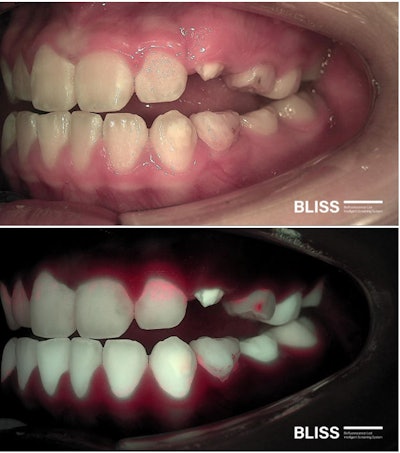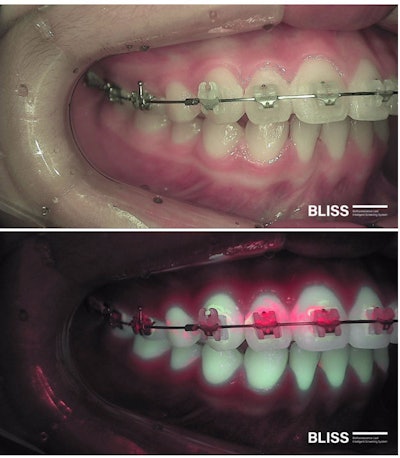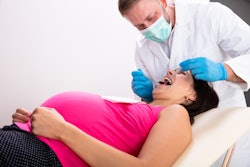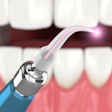Oral biofilm is part of everyday life. In modern dental practices, where preventive oral hygiene takes a bigger role in patients’ overall health and wellness, it takes on even more importance.
 Dr. Lou Shuman.
Dr. Lou Shuman.
The byproducts of oral biofilm have been associated with cardiovascular disease, chronic kidney disease, diabetes, pulmonary disease, prostate cancer, colon cancer, pancreatic cancer, preterm pregnancy, erectile dysfunction, Alzheimer’s disease, and rheumatoid arthritis.
But research has consistently shown that “Although oral biofilm formation is inevitable and can't be completely eliminated, the severity can be reduced through effective oral hygiene measures.”
Eliminating oral biofilm can help prevent or reduce its effects and maintain patients’ overall health. Since the dentist is the first line of detection and elimination of biofilm, technology-forward offices are now able to catch it sooner.
AIOBIO has developed its Biofluorescence-Led Intelligent Screening System (BLISS), a radiation-free, portable, noninvasive, and easy-to-use imaging system that helps detect biofilm at its earliest stages.
Seeing the light on biofilm
AIOBIO’s biofluorescence detection technology uses a safe, nonintrusive blue light to detect demineralization and biofilm that would be invisible to the naked eye. Under fluorescence, the white parts of the teeth are healthy, and the red shows biofilm.
Traditionally, x-rays have been the imaging of choice for diagnostic purposes. But by the time biofilm, plaque, calculus, or caries can be detected on x-rays, much of the damage to the tooth has occurred. The earlier that biofilm can be detected, the sooner the stage of caries can be evaluated and appropriate treatment started.
Beneficial throughout the practice
With the BLISS device, plaque can be detected as early as three days after it starts to accumulate. This is especially helpful in younger patients, where caries progression can be fast and cause pain.
 In an 11-year-old patient with mixed dentition, BLISS biofluorescence imaging reveals red fluorescence, indicating the presence of oral biofilm and carious lesions. Images and captions courtesy of AIOBIO.
In an 11-year-old patient with mixed dentition, BLISS biofluorescence imaging reveals red fluorescence, indicating the presence of oral biofilm and carious lesions. Images and captions courtesy of AIOBIO.
Orthodontic patients also would benefit from seeing where biofilm is growing around brackets and actually seeing how good brushing techniques and hygiene habits can prevent the need for more complicated treatment. Since BLISS does not emit ionizing radiation, parents would probably be open to more frequent checks of areas that need to be monitored.
 In a 13-year-old patient, BLISS biofluorescence imaging shows red fluorescence around brackets on the maxillary teeth, indicating biofilm accumulation despite relatively good brushing of the mandibular teeth.
In a 13-year-old patient, BLISS biofluorescence imaging shows red fluorescence around brackets on the maxillary teeth, indicating biofilm accumulation despite relatively good brushing of the mandibular teeth.
Every patient in the hygiene area can benefit from the investment in their long-term health. The images can be used to educate and inform patients on biofilm, plaque, and calculus. Hygienists can even do a “before-and-after” to show how the red areas are eliminated after proper cleaning and brushing.
With more general practices offering specialty dental services, this device can help set up other treatments for success as well. For clinicians who practice endodontics, the BLISS device can show craze lines, cracks, or fractures that can lead to sensitivity, pain, or infection.
Also, it can detect the small lesions and subtle biofilm buildups that are associated with peri-implantitis. Inflammation and bone loss caused in part by biofilm on the implant’s surface can trigger inflammatory responses and accelerate disease progression.
If the biofilm can be detected, evaluated, and removed from the implant’s surface, there is a greater likelihood that the implant can last longer. With this type of information, more individualized treatment plans can ultimately increase the detection and management of peri-implantitis.
The BLISS technology by AIOBIO is available for both office and home use. It features the LINKDENS QC, an extraoral camera for initial exams and diagnosis; the Qraypen C, a penlike intraoral camera for capturing precise and detailed screening images; the LINKDENS VU for convenient real-time oral screening and hospital use; and the Qscan Plus for patient self-assessment of oral status.
With the extra information gained by artificial intelligence-driven diagnostics, instant images, and the ability for remote patient monitoring, this biofluorescence-based technology streamlines workflows and enhances clinical decision-making and patient communication for a more individualized oral care.
Editor’s note: References available upon request.
Dr. Lou Shuman is the president and CEO of Cellerant Consulting Group and is professionally known for his expertise in Internet strategy, strategic relations, emerging technologies, digital marketing methods, and operational practice management.
The comments and observations expressed herein do not necessarily reflect the opinions of DrBicuspid.com, nor should they be construed as an endorsement or admonishment of any particular idea, vendor, or organization.



















